As you shift to remote work, you’ll discover that your standard office chair isn’t engineered for extended periods of focused productivity. From spinal alignment to blood circulation, ergonomic chairs deliver measurable benefits that directly impact your health and work performance. While the initial investment might seem substantial, the long-term advantages to your physical well-being and professional output make these specialized seating solutions worth your careful consideration. Let’s dive into the benefits of ergonomic chairs!
Key Takeaways
- Ergonomic chairs are specifically designed to support the natural curve of your spine, significantly reducing the risk of back pain and musculoskeletal disorders compared to traditional chairs.
- The adjustable features of quality ergonomic office chairs (including seat height, armrest position, and lumbar support) allow for personalized comfort that adapts to your unique body proportions.
- Investing in an ergonomic chair delivers measurable improvements in productivity by reducing discomfort-related distractions and supporting proper posture throughout the workday.
- The health benefits of ergonomic chairs extend beyond physical comfort to include improved blood circulation, reduced stress levels, and enhanced mental wellbeing.
- Quality ergonomic furniture represents a worthwhile investment in your long-term health, potentially preventing serious conditions like chronic back pain and cervical spondylosis.
What Makes a Chair Truly Ergonomic?
The concept of ergonomics revolves around designing products that work with the human body rather than forcing the body to adapt to poorly designed items. An ergonomic chair isn’t just comfortable—it’s strategically engineered to support your body’s natural posture while sitting. Unlike traditional chairs that maintain a rigid form, ergonomic chairs are adjustable to accommodate different body types and working styles.
A true ergonomic chair features adjustable seat height, allowing your feet to rest flat on the floor while keeping your knees at a 90-degree angle. The backrest should follow the natural curve of your spine, with special attention to lumbar support for the lower back region. Additional features like adjustable armrests, seat depth adjustment, and a swivel base further enhance the chair’s ergonomic qualities, ensuring that you can work comfortably without straining your body.
Why Are Ergonomic Chairs So Important for Your Health?
The health benefits of ergonomic chairs cannot be overstated, especially for those who spend more time sitting during their workday. Sitting in an ergonomic chair helps maintain a healthy posture while sitting, which is crucial for preventing musculoskeletal problems. These specially designed chairs support the natural posture of your body, reducing the strain on your muscles and joints.
Ergonomic chairs are so important because they directly address the health risks associated with prolonged sitting. They help prevent back pain by supporting the spine’s natural curve and distributing weight evenly. Additionally, proper positioning reduces the risk of developing conditions like carpal tunnel syndrome and cervical spondylosis. By promoting better sitting posture and reducing physical strain, ergonomic chairs contribute significantly to your overall health and comfort throughout the workday.
Improved Posture and Spinal Alignment
A properly designed ergonomic chair supports natural spinal curvature and promotes ideal posture during extended periods of desk work.
When you sit in an ergonomic chair, its advanced design elements work together to maintain proper alignment of your spine, from your neck down to your lower back. The chair’s adjustable features let you customize the support to your body’s unique needs.
Your ergonomic design choices directly impact your spinal health. The chair’s lumbar support cushions your lower back’s natural curve, while the adjustable seat depth prevents pressure on your thighs and knees.
You’ll find that the backrest’s tilt mechanism enables dynamic sitting, allowing your spine to move naturally throughout the day. This controlled movement helps prevent muscle fatigue and reduces the risk of developing poor postural habits.
How Do Ergonomic Chairs Improve Your Posture?
Poor posture while sitting can lead to serious health consequences over time. Ergonomic chairs are specifically designed to support proper alignment of your spine, neck, and shoulders. By providing adjustable lumbar support that conforms to the natural curve of your lower back, these chairs encourage you to maintain correct posture without conscious effort.
Using an ergonomic chair promotes better posture by keeping your shoulders relaxed and properly aligned with your hips. The adjustable features allow you to customize the chair to your body’s proportions, ensuring that you’re not hunching forward or slouching backward. Over time, sitting in an ergonomic chair helps train your muscles to maintain proper alignment even when you’re not in the chair, improving your posture while sitting and standing.
Enhanced Productivity Through Comfort
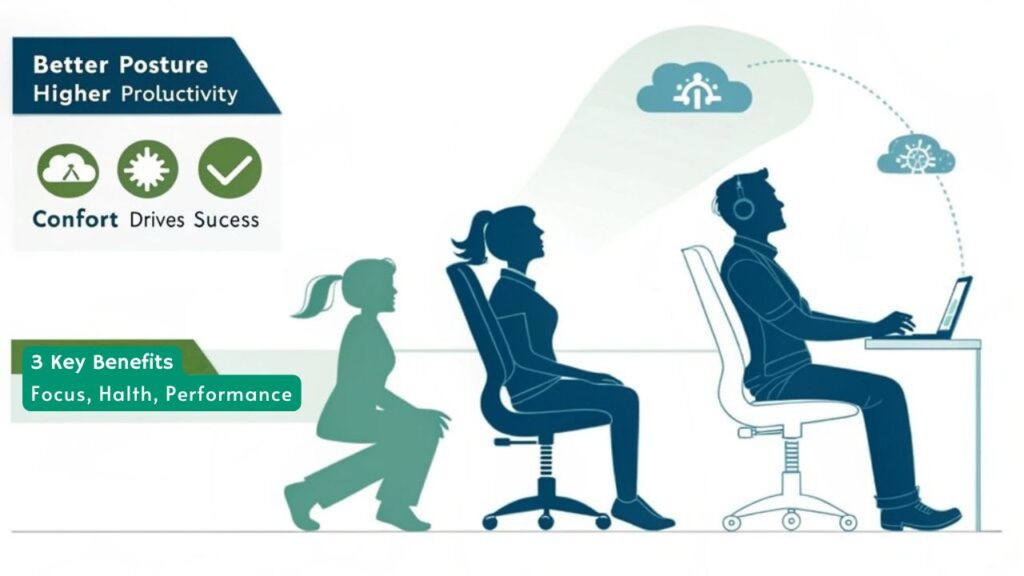
Maintaining proper posture sets the foundation for enhanced workplace performance, but comfort plays an equally significant role in your productivity. When you’re using an ergonomic chair with quality materials, you’ll experience reduced physical strain and mental fatigue throughout your workday.
The innovative design features, including premium cushioning and breathable fabrics, help regulate your body temperature and minimize pressure points.
Modern chair aesthetics contribute to your psychological comfort, creating an inviting workspace that sparks motivation. You’ll find yourself focusing more on tasks rather than constant repositioning or discomfort.
Research indicates that workers using ergonomic chairs take fewer breaks due to physical discomfort and maintain higher concentration levels. The seamless integration of comfort-enhancing features translates directly into measurable productivity gains, making ergonomic chairs a valuable investment for your home office setup.
Reduced Back and Neck Pain
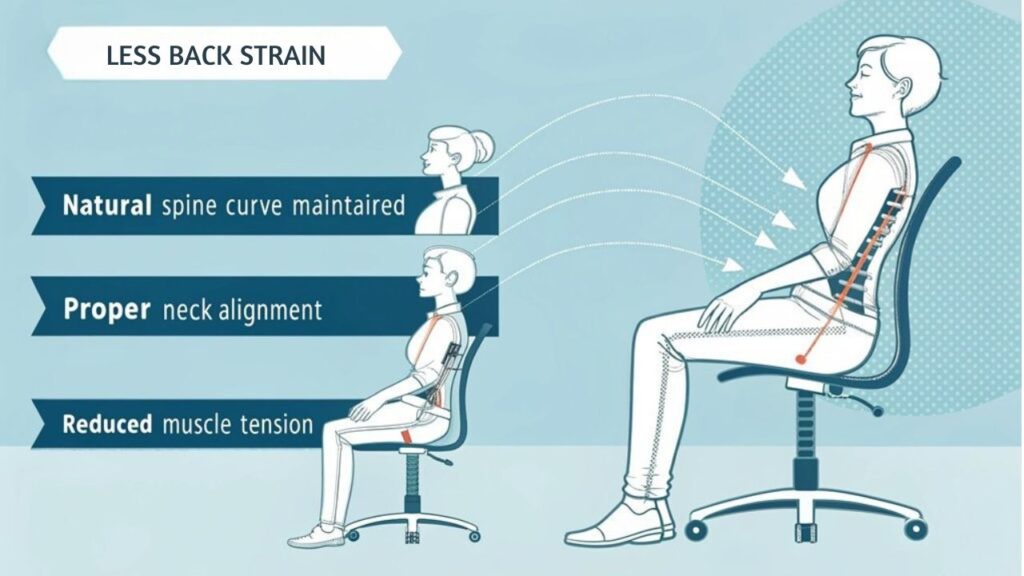
While conventional chairs often contribute to spinal misalignment, ergonomic chairs actively combat back and neck strain through targeted support mechanisms.
The ergonomic benefits extend beyond basic comfort, incorporating advanced chair materials and design elements that work together to maintain proper posture during extended work sessions.
You’ll experience significant pain reduction through:
- Dynamic lumbar support that automatically adjusts to your movements, preventing lower back compression
- Multi-axis neck support that maintains cervical spine alignment while you’re typing, reading, or viewing screens
- Pressure-distributing seat materials that promote healthy blood circulation and prevent sciatic nerve compression
These features work synergistically to reduce muscle tension and joint stress, helping you maintain ideal spinal positioning throughout your workday.
The innovative materials and adjustable components guarantee consistent support regardless of your working position.
What Are the Benefits of Ergonomic Chairs for Back Pain Sufferers?
For those already experiencing back pain, ergonomic chairs offer significant relief through targeted support. The adjustable lumbar support feature is particularly beneficial as it can be positioned to fit the specific curve of your lower back, providing crucial reinforcement to an area often strained during prolonged sitting.
A properly designed chair helps distribute your body weight evenly, reducing pressure points that can exacerbate existing back issues. The ability to recline slightly transfers some of your upper body weight to the backrest, further decreasing spinal pressure. Many back pain sufferers report notable improvement after switching to ergonomic office chairs that properly support the spine’s natural curve. By reducing the strain on back muscles and supporting proper alignment, these chairs can be an important part of managing and reducing chronic back pain.
Customizable Support Features
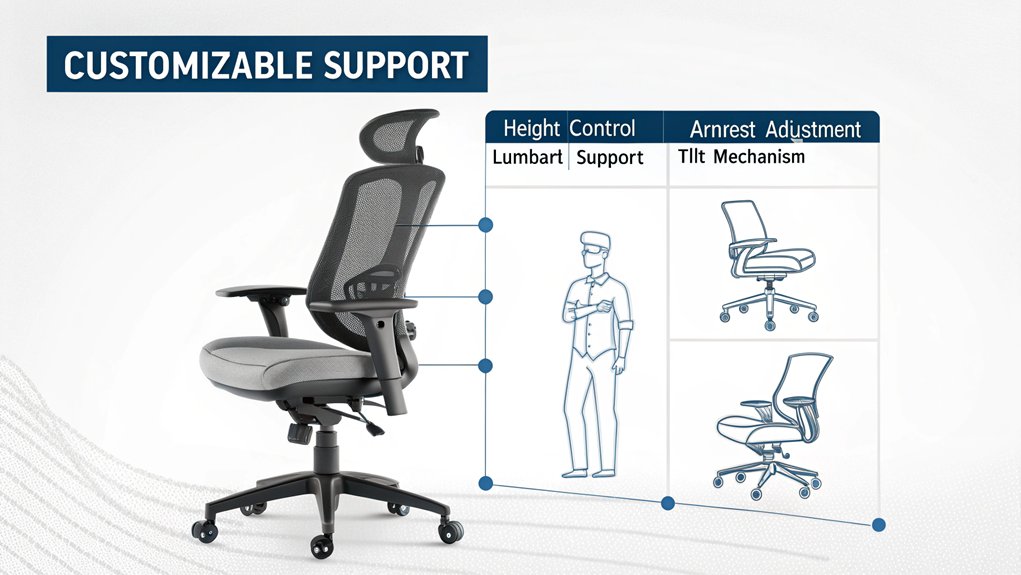
You’ll experience ideal back health with an ergonomic chair‘s adjustable lumbar support, which molds to your spine’s natural curvature.
Your ability to customize the seat height guarantees proper posture by positioning your feet flat on the floor while maintaining your thighs parallel to the ground.
The chair’s recline feature lets you shift positions throughout the day, reducing static muscle tension and promoting healthy circulation.
Adjustable Lumbar Support Benefits
Because proper spinal alignment depends heavily on lower back support, an adjustable lumbar feature serves as a critical component in ergonomic chair design.
You’ll find that customizable lumbar support directly impacts your workplace comfort and long-term back health. Through precise ergonomic adjustments, you can optimize your seated position to maintain proper posture throughout your workday.
Key benefits of adjustable lumbar support include:
- Targeted pressure distribution that prevents muscle strain and reduces lower back fatigue
- Dynamic support that adapts to your changing positions as you shift during work tasks
- Customizable depth and height settings that accommodate your unique spinal curvature
Personalized Height and Recline
Beyond lumbar adjustments, personalized height and recline settings represent core ergonomic features that directly affect your body’s positioning and comfort.
You’ll be able to optimize your seated position by adjusting your chair’s height to maintain proper alignment with your desk, ensuring your feet rest flat on the floor and your thighs remain parallel to the ground.
The recline mechanism lets you customize your chair’s tilt angle, allowing dynamic movement throughout your workday.
Modern chair materials incorporate advanced tension controls, enabling you to find your ideal resistance level when leaning back.
These ergonomic adjustments help reduce strain on your neck and shoulders while promoting better blood circulation.
You’ll discover that finding your perfect height and recline combination greatly enhances your productivity and overall comfort during extended work sessions.
Prevention of Long-Term Health Issues
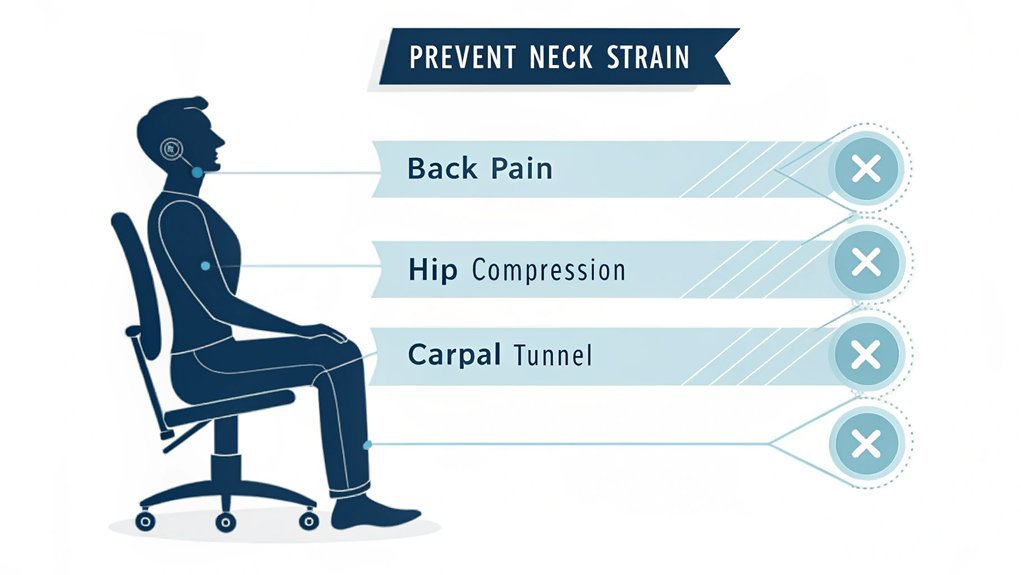
While many office workers focus on immediate comfort, investing in an ergonomic chair can prevent serious long-term health complications that often develop from poor posture and inadequate support.
The advanced ergonomic design features protect your body from strain and injury during extended work sessions, making it an essential component of workplace wellness.
You’ll minimize your risk of developing these chronic conditions:
- Musculoskeletal disorders affecting your spine, shoulders, and neck
- Repetitive strain injuries in your wrists and forearms
- Circulation problems in your legs due to prolonged sitting
Better Blood Circulation and Movement
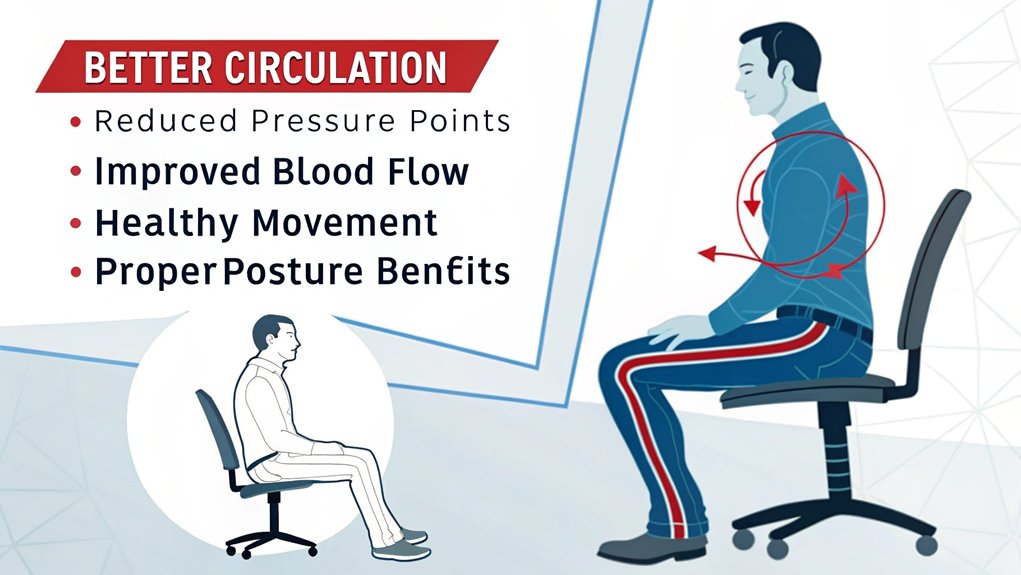
When sitting in an ergonomic chair, you’ll notice enhanced blood flow throughout your body due to the chair’s ideal positioning and support features.
The ergonomic design promotes dynamic movement, allowing you to shift positions naturally while maintaining proper alignment of your spine and limbs.
You’ll experience improved circulation as the chair’s contoured seat reduces pressure points on your thighs and buttocks.
The adjustable features enable you to customize the seat depth and height, ensuring maximum blood flow to your legs.
These health benefits extend beyond immediate comfort – the chair’s design encourages micro-movements throughout your workday, preventing blood pooling that often occurs with static sitting positions.
The seamless integration of movement-supporting features helps you maintain energy levels and mental alertness while reducing the risk of deep vein thrombosis and other circulation-related concerns.
Lower Healthcare Costs Over Time

By investing in an ergonomic chair, you’ll minimize costly doctor visits related to musculoskeletal issues and chronic pain conditions.
You’ll achieve significant long-term medical savings through reduced need for physical therapy, pain medication, and corrective treatments.
Prevention of workplace injuries through proper ergonomic support proves more cost-effective than treating compounded health problems that develop from inadequate seating.
Reduced Doctor Visit Expenses
Investing in an ergonomic chair could potentially reduce your long-term medical expenses, though scientific evidence for direct healthcare cost savings remains limited.
While you shouldn’t expect immediate reductions in your healthcare budget, proper ergonomic support may help minimize doctor visit frequency related to musculoskeletal issues.
Consider these potential cost-saving implications:
- You’ll likely require fewer specialist consultations for back, neck, and shoulder problems.
- Your need for physical therapy sessions may decrease due to better posture maintenance.
- You might reduce expenses on pain medications and therapeutic treatments.
While individual results vary, implementing proper ergonomic solutions in your home office represents a proactive approach to health management.
Track your medical expenses before and after using an ergonomic chair to evaluate its impact on your healthcare spending patterns.
Long-term Medical Savings
Scientific evidence linking ergonomic chairs to quantifiable long-term healthcare savings remains inconclusive and largely anecdotal. However, you’ll find that investing in ergonomic chair features might help prevent costly medical conditions that typically develop over years of poor posture and seating habits.
| Cost Factor | Standard Chair | Ergonomic Chair |
|---|---|---|
| Initial Cost | $100-200 | $300-800 |
| Maintenance | Low | Medium |
| Health Impact | Higher Risk | Lower Risk |
While the upfront costs of ergonomic chairs are higher, consider them long term investments in your physical wellbeing. The potential reduction in medical expenses related to back pain, neck strain, and repetitive stress injuries could offset the initial purchase price. Advanced features like adjustable lumbar support, armrests, and seat depth may help you avoid future medical treatments and rehabilitation costs.
Prevention Beats Treatment Costs
While treating chronic musculoskeletal conditions can cost thousands in medical bills, preventive measures through ergonomic office chairs typically require a fraction of those expenses.
By investing in workplace wellness through proper ergonomic design, you’ll protect yourself from potential medical costs and lost productivity.
Consider these financial advantages of prevention:
- You’ll avoid specialist visits, physical therapy, and medications that often cost $2,000-5,000 annually for chronic back issues.
- You’ll reduce the risk of surgery, which can exceed $50,000 for severe spinal conditions.
- You’ll minimize lost wages from medical leave, typically ranging from $3,000-10,000 per extended absence.
The return on investment becomes clear when you compare a quality ergonomic chair’s one-time cost against years of potential medical expenses.
This preventive approach aligns with modern workplace wellness strategies while protecting your financial future.
Frequently Asked Questions
How Long Does a High-Quality Ergonomic Office Chair Typically Last?
You’ll get 7-10 years from a high-quality ergonomic chair with proper maintenance tips like regular cleaning, tightening loose parts, and lubricating mechanisms. Chair durability varies based on usage patterns.
What Is the Average Price Range for a Good Ergonomic Chair?
You’ll find quality ergonomic chairs ranging from $200-$1,500, with budget options starting around $200-400 and premium features appearing in the $500-1,500 range, depending on materials and adjustability mechanisms.
Can Ergonomic Chairs Help With Existing Medical Conditions Like Herniated Discs?
Like a skilled chiropractor, an ergonomic chair can provide significant pain relief for your herniated discs through ideal spinal support, precise postural alignment, and customizable pressure distribution across vertebral segments.
Are Ergonomic Chairs Suitable for Both Short and Tall People?
You’ll find quality ergonomic chairs accommodate both short and tall users through height adjustment mechanisms and adjustable seat depth, letting you customize the fit to your specific body proportions and dimensions.
How Often Should You Replace the Cushioning in an Ergonomic Chair?
While you’re contemplating life’s mysteries, don’t forget your chair’s needs. You’ll want to replace cushioning every 2-3 years for ideal chair longevity, though regular cushioning maintenance extends this timeframe considerably.
Conclusion
You’ll find that ergonomic chairs transform your home office into a productivity powerhouse that’s practically capable of doubling your output. Through precise spinal alignment, customizable support features, and enhanced circulation, these chairs deliver measurable health benefits while reducing long-term medical expenses. By investing in ergonomic seating today, you’re implementing a data-driven solution that optimizes both your work performance and physiological well-being.

I am a retired software engineer with experience in a multitude of areas including managing AWS and VMWare development environments. I bought a relative a mini-PC a year ago and have become passionate about the technology and its potential to change how we deploy software.

